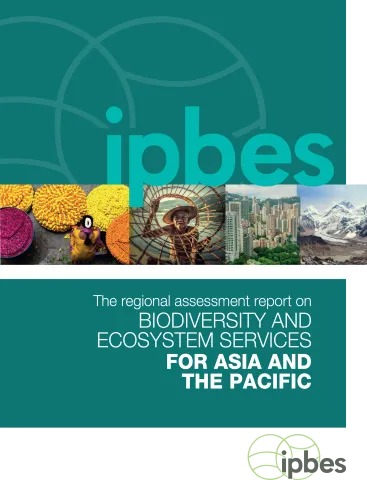Regional Assessment Report on Biodiversity and Ecosystem Services for Asia and the Pacific

Within the generic scope of the Regional Assessments of Biodiversity and Ecosystem Services, particular challenges found across the Asia-Pacific region include climate change (particularly sea-level rise, increased intensity of extreme storm events, ocean acidification and glacier retreat), population growth, poverty, human consumption of natural resources, land degradation, deforestation, invasive alien species, the impact of trade (including the illegal trade in wildlife and non-timber forest products), rapid urbanization, coastal pollution, poor governance of natural resources and the impact of altered fire regimes. These factors, together with others that have an impact on biodiversity and ecosystem services, are considered in the Assessment. There are also positive trends, such as an increase in awareness, forest cover and protected areas and a reduction in the region’s carbon footprint. Issues specific to particular Asia-Pacific subregions are also addressed, for example the interplay between food, water and energy security; biodiversity and livelihoods; waste management; and cooperative management of critical ecosystems shared by more than one country.
The Plenary approved the Summary for Policymakers and accepted the chapters of the Assessment at its 6th session in March 2018 in Medellin, Colombia (IPBES 6). IPBES would like to acknowledge and thank all of the experts who contributed to the Assessment.
The IPBES Assessment Report on Biodiversity and Ecosystem Services for Asia and the Pacific is composed of:
- A Summary for Policymakers (SPM); and
- A set of 6 chapters.
Please see below to access the Assessment Report and related documents.
The Assessment includes countries and territories in five subregions as follows:
|
Subregions |
Countries and territories |
|
Oceania |
Australia, Fiji, Kiribati, Marshall Islands, Micronesia (Federated States of), Nauru, New Zealand, Palau, Papua New Guinea, Samoa, Solomon Islands, Tonga, Tuvalu and Vanuatu. Pacific island territories of Cook Islands, New Caledonia, American Samoa,a Tokelau,a French Polynesia,a Niue,a Guam,a Commonwealth of the Northern Mariana Islands, Pitcairn Islanda and Wallis and Futuna.a Oceanic and sub-Antarctic islands in the Pacific region (or Pacific and Indian Ocean regions) |
|
South-East Asia |
Brunei Darussalam, Cambodia, Indonesia, Lao People’s Democratic Republic, Malaysia, Myanmar, Philippines, Singapore, Thailand, Timor-Leste and Viet Nam |
|
North-East Asia |
China, Democratic People’s Republic of Korea, Japan, Mongolia and Republic of Korea |
|
South Asia |
Afghanistan, Bangladesh, Bhutan, India, Iran (Islamic Republic of), Maldives, Nepal, Pakistan and Sri Lanka |
|
Western Asia |
Bahrain, Kuwait, Oman, Qatar, Saudi Arabia, United Arab Emirates and Yemen (Arabian peninsula); Iraq, Jordan, Lebanon, State of Palestine and Syrian Arab Republic (Mashreq) |
a Overseas territory.
Editors: Madhav Karki, Sonali Senaratna Sellamuttu, Sana Okayasu, Wataru Suzuki
Members of the management committee who provided guidance for the production of this assessment: Mark Lonsdale, Vinod B. Mathur, Yoshihisa Shirayama (Multidisciplinary Expert Panel), Asghar M. Fazel, Youngbae Suh (Bureau).
Suggested citation: IPBES (2018): The IPBES regional assessment report on biodiversity and ecosystem services for Asia and the Pacific. Karki, M., Senaratna Sellamuttu, S., Okayasu, S., and Suzuki, W. (eds). Secretariat of the Intergovernmental Science-Policy Platform on Biodiversity and Ecosystem Services, Bonn, Germany. 612 pages. https://doi.org/10.5281/zenodo.3237373